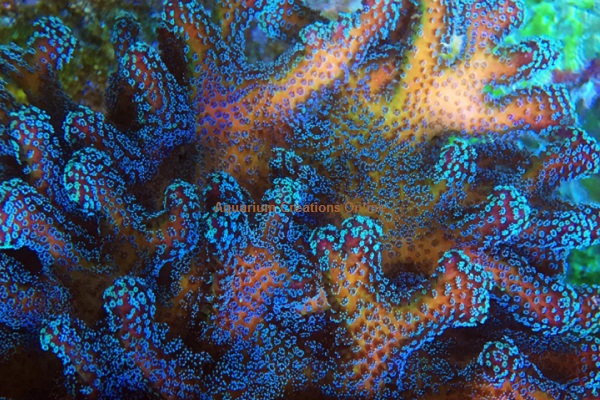Description:
The ORA Stellar Stylo has a highly variable base coloration, ranging from pink to intense red with hues of purple, fuchsia and peach while always shimmering with electric blue polyps. Its stout branches grow in a dense cluster, making this an attractive piece for those tight areas among your rockwork. ORA originally acquired this Stylophora strain from the collection of author Julian Sprung in 2012. He reported it maintained an intense red coloration while growing in his outdoor aquarium. Think of our captive grown (also called Aquacultured) SPS corals mounted on 1/2 inch diameter plugs. They are fully matured individual coral colonies. These corals are well encrusted to the base, they are fully matured as individual coral colonies. They are TRUE hobbyist frags, designed to be grown-out in the home aquarium. They are true aquacultured specimens, 6 or 7 generations removed from the original wild colonies they came from. No tissue or skeleton of wild brood-stock corals ever remain.
Difficulty Moderate
Aggressiveness Peaceful
Water-flow
Strong water movement is recommended. Porites grow in some of the heaviest flow areas on the reef.
Lighting
Prefers medium to high lighting levels. T5's, Metal Halides, or LED's can all grow sps when the proper levels are provided. Place in the top portion of the aquarium. T5's, Metal Halides, or LED's can all grow sps when the proper levels are provided. Alter its position in the aquarium depending on the lighting, and provide at least 3 watts per gallon. We recommend a 14-20K color spectrum for best coloration.
Placement
Can be placed in close proximity to other similar peaceful corals in the reef aquarium. Leave room for growth.
Diet and Feeding
All your SPS corals will be happier when they are fed. The mouth sizes for each polyp is relative to the body size of the polyp and this size will more or less determine the particle size a coral can eat. We have found that even the smallest of SPS polyps, even Anacropora will accept food. There are several coral foods available to the aquarium hobbyist and we generally mix up a few with varying particle sizes and target feed this to all of our corals. We've had success feeding all our corals and find our Echinophyllia (chalice corals) Montiporas, Acroporas especially A. millepora among others respond well to feeding. When you are feeding your corals you will want to turn off the flow in your tank and gently target each coral. We like to feed our corals at the end of the day when the lights are still on their daytime light setting. You can even try broadcasting some food in the tank before you target feed as a "dinner bell" for your corals, or try polyp lab reef booster as a way to prepare your corals to feed. We recommend feeding your corals several times per week. After a few days of feeding your corals should be responding quicker to your dinner bell and looking all and all more vibrant. Some of the benefits we have noticed after 2-3 week included more polyp extension, puffier body tissue, more colourful, increased growth (compared to unfed corals). Excellent SPS Cora food include Phyto Feast, Oyster Feast, Roti Feast, Phyto Plankton, Zoo Plankton, Marine Snow, Coral Frenzy, Cyclops. We also always recommend target feeding since it gets the corals fed using less food while keeping your nitrates and phosphates lower.
Water Chemistry
It is important that the proper calcium (420-440 ppm), alkalinity (8-9.5 dkh - run it 7-8 if you are carbon dosing) , and magnesium levels (1260-1350 ppm) are all maintained. Raising magnesium levels gradually up to 1400-1600 ppm is a great help in combating algae outbreaks, just keep Calcium and alkalinity levels where they should be as you raise the Magnesium level. Try to keep Nitrate levels below 10 ppm, Phosphate levels below .10 ppm. We recommend doing frequent water changes to keep Nitrate levels below 10 ppm. If Phosphate numbers are above the .10 ppm level, change your phosphate control media. To make the most efficient use of your phosphate media, we recommend the use of a media reactor.
|



